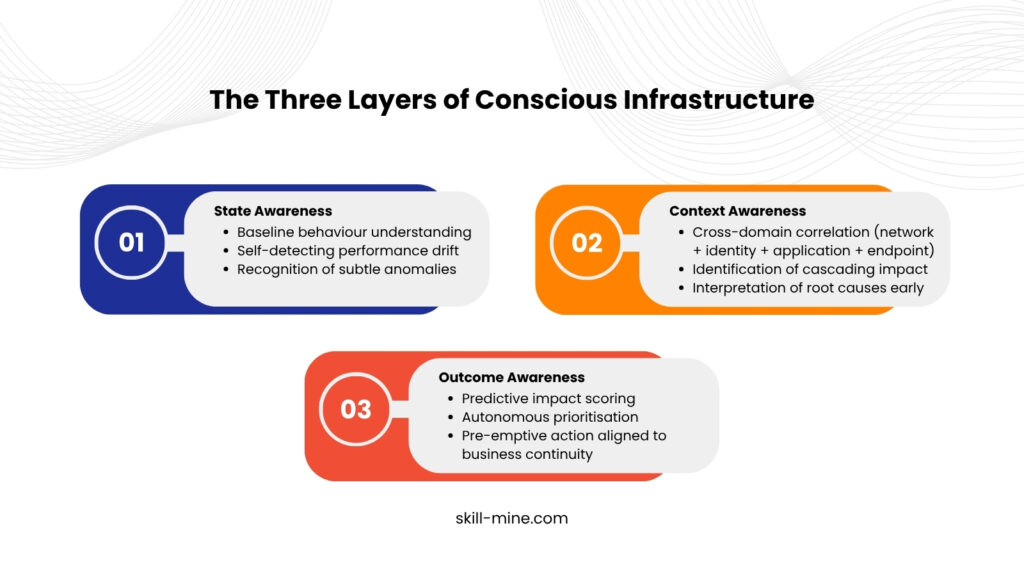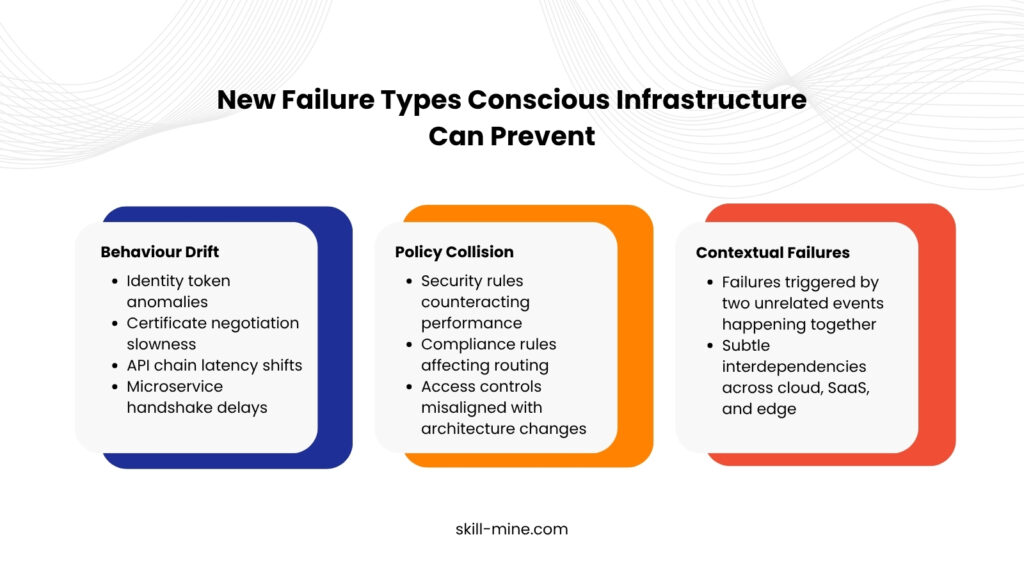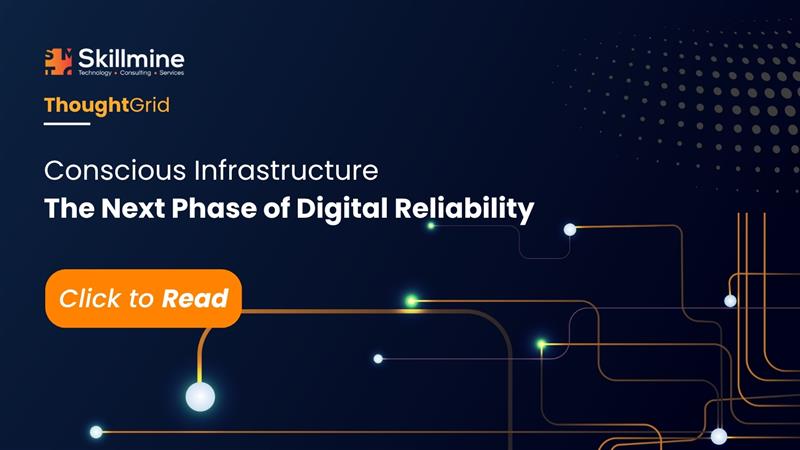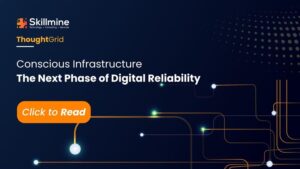Enterprises have reached a critical inflection point where the sheer velocity of digital operations outpaces conventional management capabilities: applications scale faster than teams, systems change faster than documentation, and complex failures propagate faster than alerts.
The traditional, reactive framework of “detect -> diagnose -> respond” is fundamentally insufficient for modern hybrid architectures, which integrates cloud, SaaS, edge computing, partner APIs, and identity-driven access complexities.
A new paradigm is emerging across high-maturity digital organizations: Conscious Infrastructure.
This is more than “smart” or “automated” infrastructure. It is an infrastructure engineered to interpret its own behavior and act decisively on subtle, early signals that are typically missed by human operators.
The focus is on the creation of systems that possess inherent situational intelligence, moving beyond mere data aggregation to drive insightful, proactive decision-making.
The traditional, reactive framework of “detect -> diagnose -> respond” is fundamentally insufficient for modern hybrid architectures, which integrates cloud, SaaS, edge computing, partner APIs, and identity-driven access complexities.
A new paradigm is emerging across high-maturity digital organizations: Conscious Infrastructure.
This is more than “smart” or “automated” infrastructure. It is an infrastructure engineered to interpret its own behavior and act decisively on subtle, early signals that are typically missed by human operators.
The focus is on the creation of systems that possess inherent situational intelligence, moving beyond mere data aggregation to drive insightful, proactive decision-making.

What Makes Infrastructure ‘Conscious’?
In most enterprises today, systems generate information. Conscious infrastructure goes a step further, it generates awareness.
It focuses on three capabilities:
It focuses on three capabilities:
- State Awareness The system understands when its behaviour deviates from its own norms, even if nothing is “broken.”
- Context Awareness It can correlate unrelated signals (identity drift + unusual routing + slower encryption negotiation) and interpret the bigger picture.
- Outcome Awareness It knows which deviations impact business workflows, customers, or compliance and prioritises those autonomously.

Why This Approach Matters and Why Now
Hybrid environments have introduced two new categories of failures:
1. “Invisible Failures”
Events that do not break systems but degrade them:
2. “Distributed Failures”
Issues caused by chain reactions across identity, network, and application layers. Example: a minor routing change affecting MFA flow reliability.
Conscious Infrastructure addresses by spotting directional shifts, not just errors.
1. “Invisible Failures”
Events that do not break systems but degrade them:
- Authentication slowing down by 80ms
- API timeouts increasing slightly under specific geographies
- Policy evaluation spikes during peak hours
- Token refresh cycles becoming inconsistent
2. “Distributed Failures”
Issues caused by chain reactions across identity, network, and application layers. Example: a minor routing change affecting MFA flow reliability.
Conscious Infrastructure addresses by spotting directional shifts, not just errors.
Unique Use Cases (Not Commonly Discussed)
These examples highlight scenarios where conscious infrastructure adds value in ways traditional systems cannot.
Use Case 1: Detecting Harmful Policy Interactions Before They Cause Outages
Large enterprises often run hundreds of networks, access, and compliance policies. Occasionally, two valid policies collide and create unpredictable behaviour.
Example: A new Zero Trust rule tightens lateral movement just as an API gateway updates its routing logic. Neither change is “wrong,” but together they create intermittent authentication failures.
Conscious infrastructure identifies the conflict pattern before users experience disruptions, preventing hours of investigation later.
Use Case 2: Interpreting Identity Drift as a Security Signal
Organizations focus on login failures or MFA bypass attempts. But identity drift often begins subtly:
A conscious system interprets drift as a pre-breach signal, strengthening authentication or isolating affected pathways before an incident occurs.
Use Case 3: Pre-emptive Routing Intelligence Based on Cryptographic Load
Most routing decisions are made on traffic loads, not cryptographic loads. But as more applications adopt mTLS and evolving encryption standards, cryptographic pressure becomes a performance bottleneck.
Conscious infrastructure detects trends in certificate negotiation time, renegotiation spikes, or handshake delays and shifts traffic accordingly.
This keeps systems stable during cryptographic pressure cycles that traditional monitoring overlooks.
Use Case 1: Detecting Harmful Policy Interactions Before They Cause Outages
Large enterprises often run hundreds of networks, access, and compliance policies. Occasionally, two valid policies collide and create unpredictable behaviour.
Example: A new Zero Trust rule tightens lateral movement just as an API gateway updates its routing logic. Neither change is “wrong,” but together they create intermittent authentication failures.
Conscious infrastructure identifies the conflict pattern before users experience disruptions, preventing hours of investigation later.
Use Case 2: Interpreting Identity Drift as a Security Signal
Organizations focus on login failures or MFA bypass attempts. But identity drift often begins subtly:
- Tokens refreshing earlier than usual
- Session durations behaving inconsistently
- Non-critical services requesting reauthentication Minor increase in authorization lookups
A conscious system interprets drift as a pre-breach signal, strengthening authentication or isolating affected pathways before an incident occurs.
Use Case 3: Pre-emptive Routing Intelligence Based on Cryptographic Load
Most routing decisions are made on traffic loads, not cryptographic loads. But as more applications adopt mTLS and evolving encryption standards, cryptographic pressure becomes a performance bottleneck.
Conscious infrastructure detects trends in certificate negotiation time, renegotiation spikes, or handshake delays and shifts traffic accordingly.
This keeps systems stable during cryptographic pressure cycles that traditional monitoring overlooks.

Strategic Impact for Enterprises
Conscious infrastructure transforms operations in three ways:
1. Stability as a Business Advantage
Issues are resolved before they influence user experience especially important in BFSI, healthcare, and e-commerce.
2. Smarter Risk Management
Instead of relying solely on logs, organizations gain a system that understands the intent of behaviour, not just the output.
3. Reduced Operational Complexity
Teams spend less time diagnosing and more time improving architecture and security posture.
This is not a future concept, it is the direction high-maturity digital enterprises are already moving toward as part of their stability, resilience, and Zero Trust strategies.
1. Stability as a Business Advantage
Issues are resolved before they influence user experience especially important in BFSI, healthcare, and e-commerce.
2. Smarter Risk Management
Instead of relying solely on logs, organizations gain a system that understands the intent of behaviour, not just the output.
3. Reduced Operational Complexity
Teams spend less time diagnosing and more time improving architecture and security posture.
This is not a future concept, it is the direction high-maturity digital enterprises are already moving toward as part of their stability, resilience, and Zero Trust strategies.
Closing the Gap Between Awareness and Digital Trust
As enterprises become increasingly connected and distributed, system anomalies will not always manifest as loud, obvious, or easily traceable failures. The next leap in digital reliability is contingent upon systems that can interpret their own signals, understand their context, and act with decisive intent.
Conscious Infrastructure moves us strategically from merely managing failures to proactively preempting them entirely.
In a competitive landscape where digital trust is the ultimate differentiator, this fundamental shift is not optional, it is the foundation of future business resilience and sustained market leadership.
Move beyond reactive operations. Talk to Skillmine experts about implementing Conscious Infrastructure across your digital ecosystem.
Subscribe to our newsletters to learn more.
Conscious Infrastructure moves us strategically from merely managing failures to proactively preempting them entirely.
In a competitive landscape where digital trust is the ultimate differentiator, this fundamental shift is not optional, it is the foundation of future business resilience and sustained market leadership.
Move beyond reactive operations. Talk to Skillmine experts about implementing Conscious Infrastructure across your digital ecosystem.
Subscribe to our newsletters to learn more.





